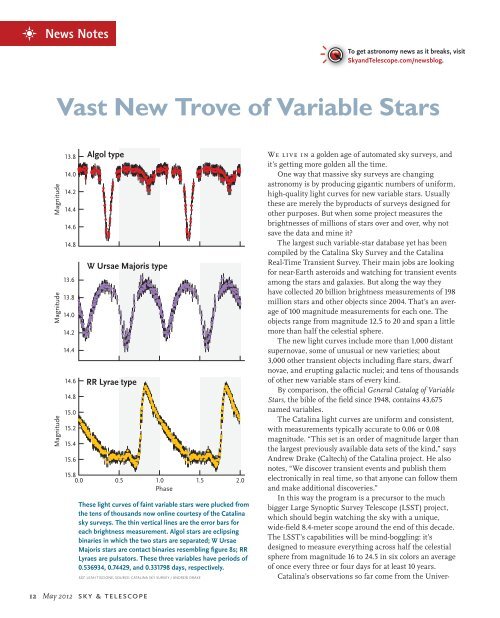Download this ebook as PDF - E-Book Library
Download this ebook as PDF - E-Book Library
Download this ebook as PDF - E-Book Library
Create successful ePaper yourself
Turn your PDF publications into a flip-book with our unique Google optimized e-Paper software.
News Notes<br />
Magnitude<br />
Magnitude<br />
Magnitude<br />
12 May 2012 sky & telescope<br />
To T get <strong>as</strong>tronomy news <strong>as</strong> it breaks, visit<br />
SkyandTelescope.com/newsblog.<br />
S<br />
V<strong>as</strong>t New Trove of Variable Stars<br />
13.8<br />
14.0<br />
14.2<br />
14.4<br />
14.6<br />
14.8<br />
13.6<br />
13.8<br />
14.0<br />
14.2<br />
14.4<br />
14.6<br />
14.8<br />
15.0<br />
15.2<br />
15.4<br />
15.6<br />
Algol type<br />
W Ursae Majoris type<br />
RR Lyrae type<br />
15.8<br />
0.0 0.5 1.0<br />
Ph<strong>as</strong>e<br />
1.5 2.0<br />
These light curves of faint variable stars were plucked from<br />
the tens of thousands now online courtesy of the Catalina<br />
sky surveys. The thin vertical lines are the error bars for<br />
each brightness me<strong>as</strong>urement. Algol stars are eclipsing<br />
binaries in which the two stars are separated; W Ursae<br />
Majoris stars are contact binaries resembling fi gure 8s; RR<br />
Lyraes are pulsators. These three variables have periods of<br />
0.536934, 0.74429, and 0.331798 days, respectively.<br />
S&T: LEAH TISCIONE, SOURCE: CATALINA SKY SURVEY / ANDREW DRAKE<br />
We live in a golden age of automated sky surveys, and<br />
it’s getting more golden all the time.<br />
One way that m<strong>as</strong>sive sky surveys are changing<br />
<strong>as</strong>tronomy is by producing gigantic numbers of uniform,<br />
high-quality light curves for new variable stars. Usually<br />
these are merely the byproducts of surveys designed for<br />
other purposes. But when some project me<strong>as</strong>ures the<br />
brightnesses of millions of stars over and over, why not<br />
save the data and mine it?<br />
The largest such variable-star datab<strong>as</strong>e yet h<strong>as</strong> been<br />
compiled by the Catalina Sky Survey and the Catalina<br />
Real-Time Transient Survey. Their main jobs are looking<br />
for near-Earth <strong>as</strong>teroids and watching for transient events<br />
among the stars and galaxies. But along the way they<br />
have collected 20 billion brightness me<strong>as</strong>urements of 198<br />
million stars and other objects since 2004. That’s an average<br />
of 100 magnitude me<strong>as</strong>urements for each one. The<br />
objects range from magnitude 12.5 to 20 and span a little<br />
more than half the celestial sphere.<br />
The new light curves include more than 1,000 distant<br />
supernovae, some of unusual or new varieties; about<br />
3,000 other transient objects including fl are stars, dwarf<br />
novae, and erupting galactic nuclei; and tens of thousands<br />
of other new variable stars of every kind.<br />
By comparison, the offi cial General Catalog of Variable<br />
Stars, the bible of the fi eld since 1948, contains 43,675<br />
named variables.<br />
The Catalina light curves are uniform and consistent,<br />
with me<strong>as</strong>urements typically accurate to 0.06 or 0.08<br />
magnitude. “This set is an order of magnitude larger than<br />
the largest previously available data sets of the kind,” says<br />
Andrew Drake (Caltech) of the Catalina project. He also<br />
notes, “We discover transient events and publish them<br />
electronically in real time, so that anyone can follow them<br />
and make additional discoveries.”<br />
In <strong>this</strong> way the program is a precursor to the much<br />
bigger Large Synoptic Survey Telescope (LSST) project,<br />
which should begin watching the sky with a unique,<br />
wide-fi eld 8.4-meter scope around the end of <strong>this</strong> decade.<br />
The LSST’s capabilities will be mind-boggling: it’s<br />
designed to me<strong>as</strong>ure everything across half the celestial<br />
sphere from magnitude 16 to 24.5 in six colors an average<br />
of once every three or four days for at le<strong>as</strong>t 10 years.<br />
Catalina’s observations so far come from the Univer-


